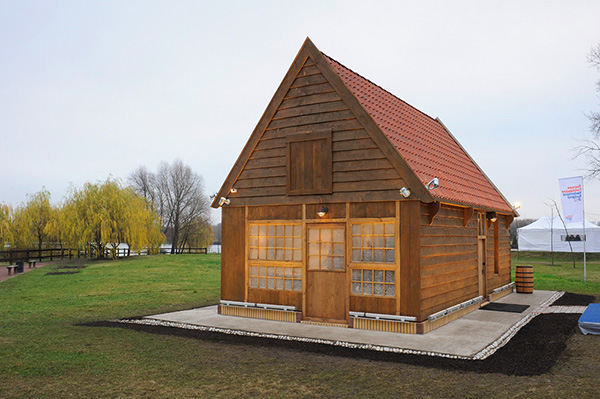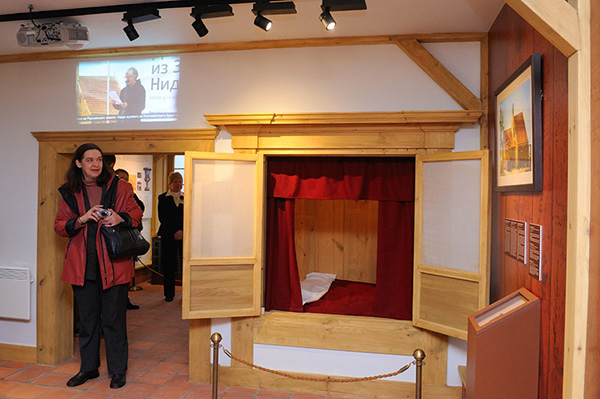
How Peter the Great Rested on His Great Embassy Mission
/ Главная / Russkiy Mir Foundation / Publications / How Peter the Great Rested on His Great Embassy MissionHow Peter the Great Rested on His Great Embassy Mission
In 1697, the young Peter spent eight August days in the shipyards of the Dutch town of Zaandam, where he studied the art of shipbuilding in the disguise of a Russian carpenter. Over three hundred years later, the museum of Zaandam presented an exact copy of the wooden two-roomed house where the Russian czar used to live to the Moscow State United Museum and Reserve. This is a very interesting present, and we will go into details about it a bit later. We would like to begin with the fact that just one hundred years ago, this authentic Dutch house of Peter the Great was a true, though tiny piece of the Russian Empire in the Kingdom of the Netherlands.

When Peter and the Great Embassy went to Western Europe, the modest dwelling of a blacksmith named Gerrit Kist was about seventy years old. With their exemplary love for anything that is memorial – and which would be a good thing for us to adopt as well, to a reasonable extent – the people of Holland could not let this original ex-residence of the Russian czar collapse.
In the late 18th century, it was first visited by Count Orlov, the chief commander of the Russian fleet, and then by the heir to the Russian throne, Pavel Petrovich. Later, Pavel’s youngest daughter, the great princess Anna Pavlovna married Prince William of Orange and the couple went to the Netherlands soon after their wedding in August 1816. In a few years, the heir was born and the happy grandfather King William I gave Peter’s house to his daughter-in-law as a present. Since that time, the house acquired a royal status and Princess Anna began to upgrade it enthusiastically, hiring a special guardian to take care of it. When King William III, the grandson of Anna and William, ascended to the throne, he gave the house to the Russian emperor Alexander III, who began the restoration process. It was Nicholas II who finally completed it in 1895, and since then, the Kingdom of the Netherlands has officially recognized Peter’s house as a Russian territory in Zaandam.
Some may say in contempt: 42 square meters, two tiny rooms – sounds like nothing worth speaking of! After all, the czar lived there for just one week, and the Dutch do not need it all. Nevertheless, for over two hundred years and several generations, we can see an attitude towards history, which is surprising for us. When revolution struck Russia (it goes without saying that the new government was quick to get rid of any property Russia had abroad, if there was no profit to derive from it), the Russian consulate asked the Zaandam Borough Council to take temporary care of the house. This temporary status lasted for over fifty years, as Zaandam officially registered municipal ownership of the house in 1971, and it acquired the status of a museum only ten years ago. Today, this is the oldest wooden building in the Netherlands. The museum had it painstakingly restored in the 2000s, and an exhibition of Peter the Great’s memorial items are accommodated there.
This Year of Holland and Russia was crowned by an exact copy of this amazing memorial building being presented to our country. The Dutch have scrupulously gathered all sections, construction materials and components and delivered them to St. Petersburg in containers carried on the naval ship Friesland. From there, the cargo was brought to Moscow by a Russian company; the house was assembled on-site by members of the Dutch and Russian engineering corps. Everything was restored to the smallest details – even the admired inscriptions made over many decades on the walls and window glass panes by tourists on the Zaandam building.

Now, Kolomenskoe has its own “Little Holland”. The impression becomes only stronger because of the location; now the house stands next to the open-air exhibition of wooden architecture on the low marshy bank of the Zhuzha River.
“Certainly, this is a newly built remake, so you cannot see the authentic things that Peter the Great would have used,” says Olga Polyakova, honored culture worker of the Russian Federation and chief curator of the Moscow State United Museum and Reserve. “However, for the opening of this exposition, we restored a leather-covered wooden trunk of the late 18th century, which we had in our reserves: it is just the type used by delegates of the Great Embassy. There are also authentic objects from those days – chairs, books on shipbuilding and navigation, and a model of a sea ship.”
Not only the dimensions and facades of the Zaandam house have been restored in detail, but also its interiors. In the center, there is a famous Dutch sleeping niche, separated from rest of the inner space with wooden doors. In comparison with the old rustic houses preserved in folklore parks of the Netherlands, Peter’s place for night rest is much more spacious and does not in any way resemble the notorious “closet drawer”. Lying there one can turn from one side to the other and stretch out their hands, though it would be difficult for Peter to stretch out his entire body there – as we know, he was over two meters tall. The fact is that people used to sleep in such “drawers” in a semi-sitting position, as in those days it was considered good for one’s health. In order to save fuel and avoid warming the entire house all night long, the bed had a special tray sliding out from beneath it, where ceramic pots with live coals were placed to keep the bed warm.
It is a pity that the Dutch did not restore this important element, but they did present to us one authentic detail of the Zaandam house! A wrought window hinge of the 17th century has been given a most honorable place in the museum exposition: they had come across this piece of history when strengthening the foundations of an old building and sent it to Russia, together with the set of parts for the house. At this moment, Peter must be smiling somewhere in heaven….
Dmitry Anokhin
| Tweet |
New publications

 Mikhail Kalatozov, a director who transformed the world of cinematography in many ways, was born 120 years ago. He was a Soviet film official and a propagandist. Above all, he was capable of producing movies that struck viewers with their power and poetic language.
Mikhail Kalatozov, a director who transformed the world of cinematography in many ways, was born 120 years ago. He was a Soviet film official and a propagandist. Above all, he was capable of producing movies that struck viewers with their power and poetic language.  Ukrainian authorities have launched a persecution campaign against the canonical Ukrainian Orthodox Church (UOC), the biggest one in the country's modern history. Over the past year, state sanctions were imposed on clergy representatives, searches were conducted in churches, clergymen were arrested, criminal cases were initiated, the activity of the UOC was banned in various regions of the country, and monasteries and churches were seized.
Ukrainian authorities have launched a persecution campaign against the canonical Ukrainian Orthodox Church (UOC), the biggest one in the country's modern history. Over the past year, state sanctions were imposed on clergy representatives, searches were conducted in churches, clergymen were arrested, criminal cases were initiated, the activity of the UOC was banned in various regions of the country, and monasteries and churches were seized.  When Nektary Kotlyaroff, a fourth-generation Russian Australian and founder of the Russian Orthodox Choir in Sydney, first visited Russia, the first person he spoke to was a cab driver at the airport. Having heard that Nektariy's ancestors left Russia more than 100 years ago, the driver was astonished, "How come you haven't forgotten the Russian language?" Nektary Kotlyaroff repeated his answer in an interview with the Russkiy Mir. His affinity to the Orthodox Church (many of his ancestors and relatives were priests) and the traditions of a large Russian family brought from Russia helped him to preserve the Russian language.
When Nektary Kotlyaroff, a fourth-generation Russian Australian and founder of the Russian Orthodox Choir in Sydney, first visited Russia, the first person he spoke to was a cab driver at the airport. Having heard that Nektariy's ancestors left Russia more than 100 years ago, the driver was astonished, "How come you haven't forgotten the Russian language?" Nektary Kotlyaroff repeated his answer in an interview with the Russkiy Mir. His affinity to the Orthodox Church (many of his ancestors and relatives were priests) and the traditions of a large Russian family brought from Russia helped him to preserve the Russian language.

 The leaders of the Friends of the Great Russia cultural association (Amici Della Grande Russia) in Italy believe that the Western policy of abolishing Russian culture in Europe has finally failed. Furthermore, it was doomed to failure from the beginning.
The leaders of the Friends of the Great Russia cultural association (Amici Della Grande Russia) in Italy believe that the Western policy of abolishing Russian culture in Europe has finally failed. Furthermore, it was doomed to failure from the beginning.  Name of Vladimir Nemirovich-Danchenko is inscribed in the history of Russian theater along with Konstantin Stanislavski, the other founding father of the Moscow Art Theater. Nevertheless, Mr. Nemirovich-Danchenko was a renowned writer, playwright, and theater teacher even before their famous meeting in the Slavic Bazaar restaurant. Furthermore, it was Mr. Nemirovich-Danchenko who came up with the idea of establishing a new "people's" theater believing that the theater could become a "department of public education."
Name of Vladimir Nemirovich-Danchenko is inscribed in the history of Russian theater along with Konstantin Stanislavski, the other founding father of the Moscow Art Theater. Nevertheless, Mr. Nemirovich-Danchenko was a renowned writer, playwright, and theater teacher even before their famous meeting in the Slavic Bazaar restaurant. Furthermore, it was Mr. Nemirovich-Danchenko who came up with the idea of establishing a new "people's" theater believing that the theater could become a "department of public education."  "Russia is a thing of which the intellect cannot conceive..." by Fyodor Tyutchev are famous among Russians at least. December marks the 220th anniversary of the poet's birth. Yet, he never considered poetry to be his life's mission and was preoccupied with matters of a global scale. Mr.Tyutchev fought his war focusing on relations between Russia and the West, the origins of mutual misunderstanding, and the origins of Russophobia. When you read his works today, it feels as though he saw things coming in a crystal ball...
"Russia is a thing of which the intellect cannot conceive..." by Fyodor Tyutchev are famous among Russians at least. December marks the 220th anniversary of the poet's birth. Yet, he never considered poetry to be his life's mission and was preoccupied with matters of a global scale. Mr.Tyutchev fought his war focusing on relations between Russia and the West, the origins of mutual misunderstanding, and the origins of Russophobia. When you read his works today, it feels as though he saw things coming in a crystal ball...